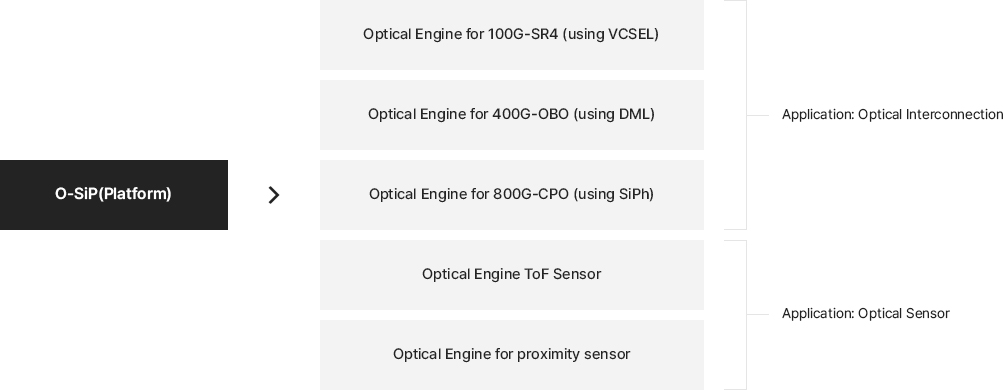Optical Engine
Technologies
What is Optical Engine?
Optical engine refers to a part that implements the most essential functions in a module/product that uses optics. Just as the engine provides power to a car to implement the core function that enables the vehicle to move, the role of the optical engine in the optical module lies in the realization of the core optical function. The configuration of the optical engine includes the optical setup with electronics and control unit.
The function of the optical engine may vary depending on the application. For example, in optical interconnection module, the optical engine is a part that includes a function by converting optical and electrical signals. In the optical sensor module, the optical engine is a part that includes a function to receive the light for image sensing, and when the light source needs to be controlled within the sensor system, the light source and the light source control unit are included. Optical engine groups parts that perform key functions into one unit, and O-SiP is the most suitable technology to integrate various parts for optical engine within a single semiconductor package.
The optical module can be completed by assembling the optical engine and additional blocks as shown in the figure below. In the optical transceiver, the additional block is composed of customized lens and fiber. In the ToF sensor module, which is a kind of optical sensor, the diffuser, lens and its holder are used as an additional block. In particular, the optical engine manufactured with O-SiP provides robust advantages in the assembly because the optical element is completely passivated. If an optical device, vulnerable to external environment and contamination, is used in the form of a conventional chip on board, problems may occur during the assembly process, but the passivated O-SiP has improved ease assembly and robust reliability.
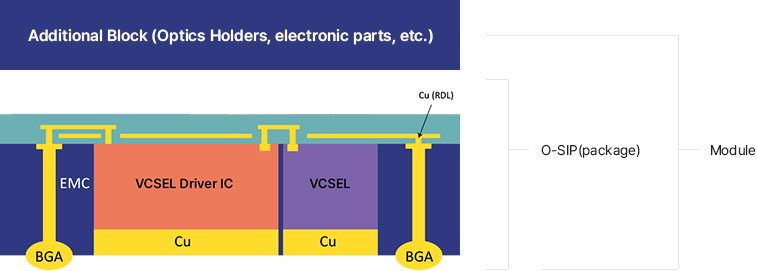
The O-SiP platform provided by LIPAC can be used, as follows, to manufacture optical engines of various specifications and used in optical connection/optical sensor applications. In the field of optical connection, short-reach products using VCSEL (100G-SR4, 400G-SR8, etc.), long-reach optical connection products using DFB laser (100G-LR4, 400G-FR4, etc.), On-Board Optics (OBO) or optical engines covering Co-Packaged Optics (CPO) applications can also be built with the same O-SiP platform. In addition, for sensors, proximity sensors and ToF sensors that use VCSELs are manufactured to be ultra-thin, making it possible to realize ultra-thin sensors suitable for mobile/IoT systems with limited space.
Module assembly for the O-SiP optical engine is generally performed in the following order: 1) SMT on PCB, 2) Additional Optical Block assembly, and 3) Housing assembly. Compared with the existing COB method, the die bonding and wire bonding processes can be omitted.
The above procedure may vary depending on the application, but for better understanding, the typical procedure of manufacturing the optical transceiver by the O-SiP 100G-SR4 optical engine is shown in the figure below.
-
SMT on PCB
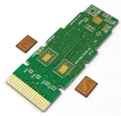
Prepare parts: PCB, optical Engine, electrical components
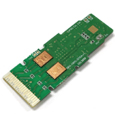
SMT: Reflow with other electrical components
-
Assembly of Additional Optical Components
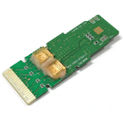
Align and fix the optical lens

Assemble the optical fiber and other optical components
-
Assembly of Housing
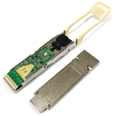
Assemble the module to the housing
After preparing the components for SMT (O-SiP, electronic device, PCB), the prepared components are mounted on the PCB through the SMT process. After aligning and fixing the O-SiP and lens on the mounted PCB, the optical fibers are connected to the lens and additional optical components (Jumper, MT Ferrule, etc.) are assembled. Finally, assemble the prepared module into the QSFP type transceiver housing.
